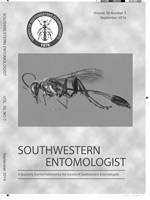Athel, saltcedar, siempreverde, rompeviento, or pinabete (Tamarix aphylla (L.) Karsten) is an exotic ornamental tree important for shade and wind protection in northern Mexico. There, the tree is defoliated by Diorhabda beetles, especially the subtropical tamarisk beetle, Diorhabda sublineata (Lucas), introduced for biological control of other invasive, shrubby Tamarix spp. The damage is conspicuous in Mexican communities in the Rio Grande and Conchos River basins, in Chihuahua State. To protect athel trees against damage by D. sublineata, we evaluated the effect of insecticide treatment on trees (one drench, 70 g active ingredient of imidacloprid per tree, for trees with approximately 1-m-diameter trunk bases) on foliage consumption by and insect knock-down of Diorhabda beetles at Ojinaga, Chihuahua, Mexico. One hundred sixteen days after treatment, fresh foliage was taken from treated and check trees to feed D. sublineata adults and larvae in a laboratory. The parameters of insecticide performance were: quantities of excrement (droppings) produced (as indicator of foliage consumption) and irreversible knockdown and convulsions of beetles; both were evaluated after insects were exposed to field-treated foliage for 14 hours in the laboratory. After this time, 100% of adult insects on non-treated foliage produced large amounts of droppings and showed no knockdown; on the other hand, when adult insects were fed foliage from the two treated sites, 100 and 86.6% produced few droppings and 33.3 and 42.2% showed knockdown, respectively. When fed foliage from the nontreated tree for 14 hours, 100% of larvae produced large amounts of droppings and showed no knockdown, while 87.5 and 50% of larvae produced few droppings and 47.5 and 28.7% showed knockdown when fed foliage from imidacloprid-treated sites. The amount of droppings and number of knocked-down insects and larvae were significantly different among treated and check trees. Drench application of imidacloprid can be a simple tool to prevent undesirable defoliation of athel trees at Chihuahua.
How to translate text using browser tools
1 September 2014
Imidacloprid Drench on Athel Trees (Tamarix aphylla): Effect on Foliage Consumption and Knock-Down of Diorhabda sublineata at Chihuahua, Mexico
Gregorio Adán Estrada-Muñoz,
Sergio R. Sánchez-Peña
ACCESS THE FULL ARTICLE

Southwestern Entomologist
Vol. 39 • No. 3
September 2014
Vol. 39 • No. 3
September 2014




